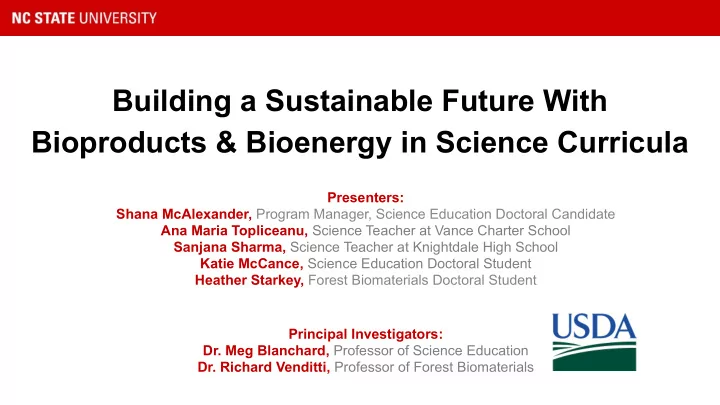

Building a Sustainable Future With Bioproducts & Bioenergy in Science Curricula Presenters: Shana McAlexander, Program Manager, Science Education Doctoral Candidate Ana Maria Topliceanu, Science Teacher at Vance Charter School Sanjana Sharma, Science Teacher at Knightdale High School Katie McCance, Science Education Doctoral Student Heather Starkey, Forest Biomaterials Doctoral Student Principal Investigators: Dr. Meg Blanchard, Professor of Science Education Dr. Richard Venditti, Professor of Forest Biomaterials
Sustainable Development Goals & a Circular Bioeconomy
The Sustainable Bioproducts & Bioenergy Program Program Goals 1. Create a professional development program for high school teachers 2. Promote awareness and interest in Bioeconomy Careers with bioproducts and bioenergy lesson activities for high school STEM disciplines.
SBBP Program Overview for Teachers • • • • • • •
Bioproduct/Bioenergy Lesson 1: Energy Diagram 1. 2 min: Think, Pair, Share on renewable/nonrenewable energy resources 2. Short whole class discussion on energy resources 3. Compare Sankey Diagram 2008 vs 2018 and identify 4 changes between the two diagrams and present findings. Discuss why http://needtoknow.nas.edu/energy/interactive/our-energy-system/ you think the changes occured. https://flowcharts.llnl.gov/commodities/energy
Bioproduct/Bioenergy Lesson 2: Carbon Footprint and Recycling Projects Sanjana Sharma’s Video 11 minutes
Bioproduct/Bioenergy Lesson 3: Recycling Paper Conserve natural resources 65.7% Reduce green- of paper was recycled in 2018 Save house Why? energy gases Free up landfill space
Types of Contaminants: • color • staples • paperclips • sticky-notes • ink • dirt • etc.
Bioproduct/Bioenergy Lesson 3: Recycling Paper 1. Blend paper into recycled pulp slurry 2. Remove ink particulars using flotation and the addition of a surfactant 3. Make a handsheet of the “cleaned” pulp 4. Quantify contaminate removal 5. Optimize contaminate removal using a design of experiment a. Possible variables to change: amount of surfactant, length of flotation, water temperature
Flotation Making a handsheet 1. Tear one sheet of paper and 1. Submerge handsheet mold in blend for 45 seconds water inside the plastic tub 2. Move blender to aluminum tray 2. Add the pulp into the handsheet 3. Fill blender to the lip with water mold 4. Add 5 drops of surfactant 3. Lift mold carefully and allow to 5. Place air pump into blender and drain then place on flat surface turn on for one minute while 4. Remove the top of mold scraping the foam over the side 5. Place 2 blotters on the wet pad of the blender as it bubbles up and press with hand 6. Remove blotters and lift the sheet off the handsheet mold simultaneously
Reflection on Activities 1. What are your major takeaways from these activities? 2. Could you envision implementing similar activities in your teaching/learning environment? 3. Do you have suggestions for modification/differentiation for other teaching/learning environments? 4. Other comments and questions?
Acknowledgements This project is supported by the USDA-NIFA project, award number: 2017-67009-26771
Thank you! Lesson Videos and Teacher/Student guides available at go.ncsu.edu/sbbp Shana McAlexander slmcalex@ncsu.edu Ana Maria Topliceanu topliceanua@vancecharter.org Sanjana Sharma sanjanas953@gmail.com Heather Starkey hrstarke@ncsu.edu Katie McCance krmccanc@ncsu.edu
Recommend
More recommend